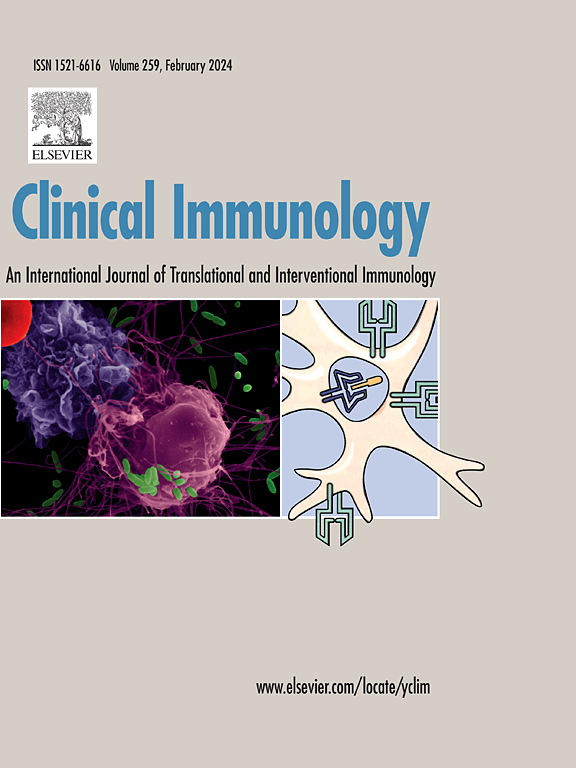Mitochondrial bioenergetic failure in SLE immunocytes: Targeting fitness for therapy
IF 3.8
3区 医学
Q2 IMMUNOLOGY
引用次数: 0
Abstract
Background
Systemic Lupus Erythematosus (SLE) is characterized by dysregulated immune responses linked to immunometabolic perturbations. While mitochondrial dysfunction has been implicated in SLE, its cell-type-specific impact on immune subsets remains underexplored.
Methods
We repurposed existing RNA-seq data from SLE patient peripheral blood mononuclear cells, with a focus on nuclear-encoded mitochondrial (NEmt) genes, as well as mitochondrial genes themselves, to identify differentially expressed genes compared to healthy controls. Mitochondrial stress tests were performed on freshly isolated CD4+ T cells, CD8+ T cells, B cells, and monocytes from SLE patients and healthy donors to assess bioenergetic function.
Results
RNA-seq revealed that both NEmt genes and mitochondrial genes were downregulated in the PBMC population of SLE patients. In situ mitochondrial stress tests revealed significant reductions in oxygen consumption rate (OCR), indicating impaired oxidative phosphorylation (OXPHOS) across all immune subsets, while extracellular acidification rate (ECAR), a marker of glycolysis, remained unchanged. These findings highlight immune-cell-specific mitochondrial bioenergetic failure in SLE, without compensatory glycolytic adaptation.
Conclusion
Our results position mitochondrial fitness as a novel therapeutic target in SLE. We propose leveraging high-throughput screening of mitochondria-targeted compounds, including FDA-approved agents, to enhance OXPHOS, regulate mitophagy, or mitigate oxidative stress. This precision-based approach offers a paradigm shift from conventional immunosuppression to metabolic recalibration, with the potential to restore immune homeostasis in SLE.
Systemic Lupus Erythematosus (SLE) is characterized by dysregulated immune responses linked to immunometabolic perturbations. While mitochondrial dysfunction has been implicated in SLE, its cell-type-specific impact on immune subsets remains underexplored.Using existing RNA-seq data we focused on nuclear-encoded mitochondrial (NEmt) genes, as well as mitochondrial genes themselves. Mitochondrial stress tests were performed on freshly isolated CD4+ T cells, CD8+ T cells, B cells, and monocytes from SLE patients and healthy donors to assess bioenergetic function.RNA-seq revealed that both NEmt genes and mitochondrial genes were downregulated in the PBMC population of SLE patients. In situ mitochondrial stress tests revealed significant reductions in oxygen consumption rate, indicating impaired oxidative phosphorylation across all immune subsets, while glycolysis remained unchanged. These findings highlight immune-cell-specific bioenergetic failure in SLE and propose mitochondrial fitness as a novel therapeutic target in SLE. This precision-based approach offers a paradigm shift from conventional immunosuppression to metabolic recalibration.
SLE免疫细胞线粒体生物能量衰竭:靶向适应度治疗
系统性红斑狼疮(SLE)的特点是与免疫代谢紊乱相关的免疫反应失调。虽然线粒体功能障碍与SLE有关,但其对免疫亚群的细胞类型特异性影响仍未得到充分研究。方法:我们重新利用SLE患者外周血单个核细胞的现有RNA-seq数据,重点研究核编码线粒体(NEmt)基因以及线粒体基因本身,以识别与健康对照组相比差异表达的基因。对来自SLE患者和健康供体的新鲜分离的CD4+ T细胞、CD8+ T细胞、B细胞和单核细胞进行线粒体应激测试,以评估生物能量功能。结果rna -seq结果显示,SLE患者PBMC人群中NEmt基因和线粒体基因均下调。原位线粒体应激测试显示氧气消耗率(OCR)显著降低,表明所有免疫亚群的氧化磷酸化(OXPHOS)受损,而细胞外酸化率(ECAR)(糖酵解的标志)保持不变。这些发现突出了SLE中免疫细胞特异性线粒体生物能量衰竭,无代偿性糖酵解适应。结论我们的研究结果表明线粒体适应度是SLE的一个新的治疗靶点。我们建议利用高通量筛选线粒体靶向化合物,包括fda批准的药物,来增强OXPHOS,调节线粒体自噬或减轻氧化应激。这种基于精确的方法提供了从传统免疫抑制到代谢重新校准的范式转变,具有恢复SLE免疫稳态的潜力。系统性红斑狼疮(SLE)的特点是与免疫代谢紊乱相关的免疫反应失调。虽然线粒体功能障碍与SLE有关,但其对免疫亚群的细胞类型特异性影响仍未得到充分研究。利用现有的RNA-seq数据,我们专注于核编码线粒体(NEmt)基因,以及线粒体基因本身。对来自SLE患者和健康供体的新鲜分离的CD4+ T细胞、CD8+ T细胞、B细胞和单核细胞进行线粒体应激测试,以评估生物能量功能。RNA-seq显示,在SLE患者的PBMC人群中,NEmt基因和线粒体基因均下调。原位线粒体应激测试显示氧气消耗率显著降低,表明所有免疫亚群的氧化磷酸化受损,而糖酵解保持不变。这些发现强调了SLE中免疫细胞特异性的生物能量衰竭,并提出线粒体适应性是SLE的一个新的治疗靶点。这种基于精度的方法提供了从传统免疫抑制到代谢重新校准的范式转变。
本文章由计算机程序翻译,如有差异,请以英文原文为准。
求助全文
约1分钟内获得全文
求助全文
来源期刊

Clinical immunology
医学-免疫学
CiteScore
12.30
自引率
1.20%
发文量
212
审稿时长
34 days
期刊介绍:
Clinical Immunology publishes original research delving into the molecular and cellular foundations of immunological diseases. Additionally, the journal includes reviews covering timely subjects in basic immunology, along with case reports and letters to the editor.
 求助内容:
求助内容: 应助结果提醒方式:
应助结果提醒方式:


